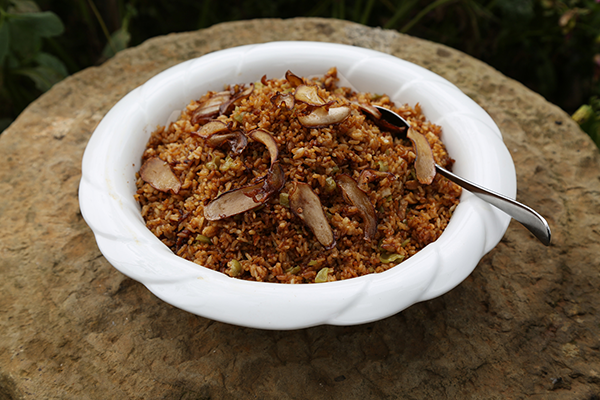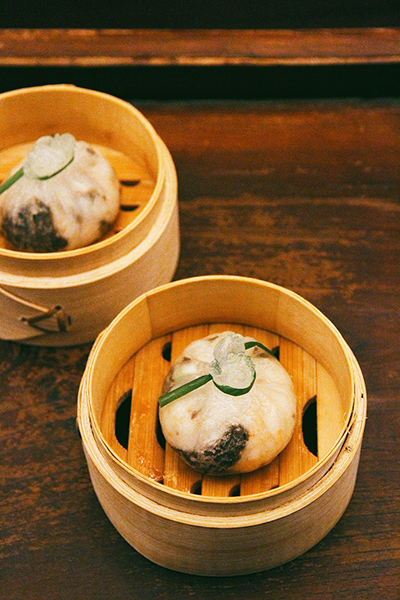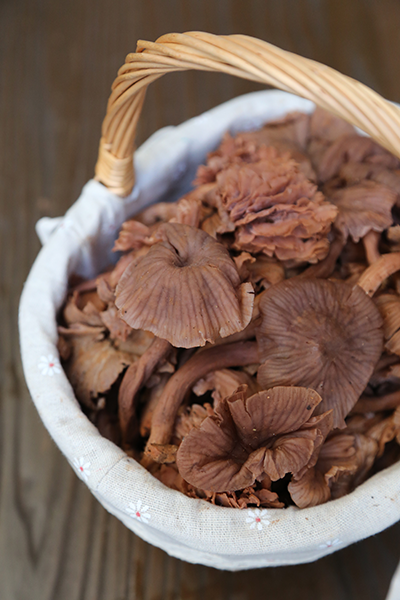Natural treasures from Yunnan mountains

Fried rice with wild fungi. [Photo provided to China Daily]
While the untypical weather in Southwest China's Yunnan province this summer has resulted in disastrous floods and mudslides, it has been good news for the region's mushroom dealers, as half the average rainfall from May to early June, followed by 40 days of consecutive storms has made wild, edible mushrooms scarce, pushing up prices.
"The prices of wild fungi, matsutake in particular, have soared," says Yan Ji, a 32-year-old native of Kunming, who is one of hundreds of mushroom dealers in the province.
For locals like Yan, there is a strict distinction between gu, cultivated mushrooms that are available all year around, and jun, edible fungi that are picked in the wild between July to early September every year. The price of the latter is naturally five to 10 times higher than the former, if not more.
While mushrooms are a traditional delicacy in the province and the province's edible fungi are exported all over the world, it is only in the last two to three years that they have captured the attention of gourmands in China's metropolises including Shanghai, Beijing and Guangzhou, who have belatedly discovered these tasty treasures of nature.
Yan, who joined the family business that primarily wholesales pricy fungus and vegetables to Japan and South Korea, notes that exports used to account for 90 percent of his company before 2014. Then domestic consumption of the fungus started to pick up.
His company, Xintian Fungus, is one of the 12 top exporters in Yunnan province licensed by the local government and has been in the business for more than two decades.

Steamed lobster dumplings with morel mushrooms. [Photo provided to China Daily]
"Usually, we should have wrapped up our business this time of the year, as exports to Japan, our main target, is ending. But this year, the demand has not started to wane yet," Yan says.
Considered a delicacy and given as a gift all year around in Japan, the Obon Festival, more commonly known as Japanese ghost festival, which falls on Aug 10 this year, is usually the peak period of demand for matsutake. The price of the fungus will experience a sharp slump after the festival as demand drops. But not this year.
The unusual weather has cut the reduced supply of matsutake by 90 percent, according to the association. This has prompted something of a fungi rush, with people flooding in to the province hoping to cash in.
"People who used to sell beauty products such as face masks and liquid collagen online are coming, and they have greatly disrupted the way we deal with local mushroom hunters by intercepting the mushroom hunters as they leave the forest and offering them unreasonably high prices for what they have picked," Yan says.
Yet, Yan admits, because of these people, he is making a higher profit even though he is selling less, as the price of matsutakes in Yunnan has rocketed to 3,000 yuan ($450) per kilo this year.
"I think if Shanghainese kept buying like this from me, and matsutake were available all year around, I would be able to buy my own apartment in Shanghai," jokes Yan, noting that at his online retail store on Taobao, more than half of the purchases were delivered to addresses in East China's Yangtze River region, especially Shanghai.[page]

Malaysian chef Otto Goh is one of those who has been attracted to put Yunnan fungus on his menu. [Photo provided to China Daily]
But chef Lu Yiming, arguably Shanghai's most recognized chef who runs two Michelin-starred restaurant, might disagree.
The Shanghai native believes it's precisely the brief period of the fungi that makes it such a sought after delicacy.
"Eating seasonal fare is, ironically, the most ancient and also the most trendy food philosophy in China," says Lu. At Yong Yi Ting, the Michelin one-starred restaurant under luxury hotel brand Mandarin Oriental Pudong, Shanghai that offers East China's Huaiyang cuisine, he curates two more themed and seasonal menus aside from the usual spring, autumn, winter and summer ones. These are hairy crabs, a river food available from late October to December and in East China only, and fungus from Yunnan.
"Yunjun (short for Yunnan fungus) doesn't really fit into the concept of eating local. But it's native to China, and offers a variety of possibilities to showcase the refined culinary style of Huaiyang cuisine," says Lu.
On his fungus themed menu this year, which offers a dozen choices ranging from appetizers to soup and dim sums, he manages to give them a Shanghainese twist by having them red braised like pork cubes or stir-fried with green vegetables.

Free range black pork and fungus [Photo provided to China Daily]
Over the past two years, a growing variety of restaurants, ranging from Shanghainese to Cantonese and even Western style restaurants, have been putting Yunnan fungi on their menus.
Malaysian chef Otto Goh, who runs The Cook at Kerry Hotel Shanghai, is one of those who has been attracted to put yunjun on his menu.
A popular dining destination for local expats, his all-day dining restaurant usually sees a dip in business in summer as the foreign staff of multinational companies head out of town on their summer vacations. Therefore, after three trips to Yunnan during the fungus season, one made last year and two this year, the 44-year-old made a rather bold decision in order to drive business: pan-fried matsutake buffet style at the price of 298 yuan ($45), plus another six to seven fungi dishes he learned from locals during his trips.
"The philosophy is simple: offering the best at the lowest price possible during the worst season. There is a Chinese saying the good wine can be found even deep in the alley," says Goh.
He says with their unique earthy aroma and fleshy texture the mushrooms are becoming more popular with young Chinese who are more aware of healthy eating than the older generation.
Editor: Eric Wang